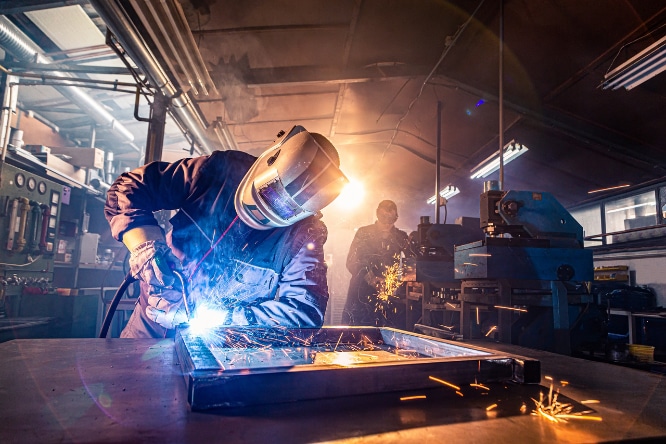Interested in a career where you can work with your hands and take on new challenges? If so, and if you’re also looking for a career that doesn’t require extensive time in school, then working in the welding industry may be right for you.
Specifically, welders are professionals who use special equipment to join metals together. And because there are many applications for welding, you can explore different specializations and find the path that best suits your interests.
So, what’s the appeal of a career in welding, and what will you need to do to break into this exciting field? We’ll walk you through every step in this comprehensive career guide.
What to Know About the Welding Industry
Before we dive further into the steps you’ll need to complete to start working as a welder, it’s important for you to understand exactly what this line of work entails and why welders play such an important role in many areas of everyday life.
What Welding Is and Why It’s Essential
Welding is a process where two materials are joined together with special equipment that heats the materials into a molten state before fusing them together. Typically, metals are the most common materials that are welded, but other materials (including alloys and plastics) can be used as well.
Welding is essential in keeping many industries moving forward. In the automotive industry, for example, welding is critical for building vehicle frames. In construction and manufacturing, welding is also used to create structural frameworks, build machinery, and much more. Some other examples of industries where welding is relied upon include:
- Public transportation
- Infrastructure
- Art
- Aerospace
The Various Paths Within a Welding Career
If you’re thinking about pursuing a career in welding, another thing to keep in mind is that there are plenty of potential career paths that you can explore. The path or specialization that’s right for you may depend on your unique interests and skills, as well as whether you’re prepared to earn additional certifications or pursue more training.
Some examples of the common specializations within the welding industry include:
- Arc welding
- Pipe welding
- Fabrication
- Aerospace welding
- Underwater welding
- Welding inspection
No matter what area of welding interests you most, there are likely to be plenty of welding career opportunities to explore.
The Appeal of a Career in Welding
Before you commit to the education and training required to become a welder, how can you be sure that this career path is right for you? There are a few things you’ll want to take into consideration, ranging from overall levels of job satisfaction in the industry to opportunities for advancement and salary expectations.
Job Satisfaction and Opportunities for Advancement
Those who work in welding tend to enjoy average to above-average rates of job satisfaction, which may have something to do with the fact that welders enjoy a fair amount of autonomy in their work and get to enjoy new experiences on a regular basis. According to one CareerExplorer study, welders rated their career happiness at 3.1 out of five stars — which is in line with the satisfaction ratings in similar careers (such as locksmithing and building inspection).
Preparing for Your Welding Career
Interested in exploring career opportunities in welding? If so, then you may be wondering what kinds of skills, qualifications, and equipment you will need to get started. Let’s dive in.
Essential Skills and Qualifications
Welders need to possess a number of soft and technical skills to do their jobs well. One of the most important skills that welders need to have is strong attention to detail, as even the seemingly smallest of errors in a welding project can have catastrophic consequences. Likewise, welders need to have excellent manual dexterity as they work with their hands. Being physically fit is also helpful as a welder, as some aspects of the job can be rather physically demanding.
In some cases, welders may need to be able to read blueprints to do their jobs, so this is a good skill to have if you’re thinking about entering this field.
When it comes to soft skills, welders will also benefit from being good communicators with excellent problem-solving abilities.
Necessary Equipment to Get Started
Welders rely on a lot of different equipment to do their jobs. Some of this equipment will be supplied directly by a welder’s employer, but welders are expected to carry a lot of their own gear as well. Some examples of the kinds of tools, equipment, and gear that welders need to have on-hand include:
- Shielding
- A welding machine
- A welding helmet
- Welding gloves
- Welding boots
- Angle grinders
- Chipping hammers
Step-by-Step Guide to Becoming a Welder
Ready to discover career opportunities in welding? Before you can enter the field, you’ll need to develop the essential skills covered above and follow the necessary steps to begin working as a professional welder.
Step 1: Gaining Basic Knowledge and Skills
Welding is a highly technical field that requires a great deal of knowledge and skill that simply cannot be learned overnight. The level of formal education you will need to gain this knowledge/skill will really depend on what specific welding role you’re pursuing. Some roles may only require a high school diploma or equivalent (such as a GED), whereas others may require formal certification and a specialized diploma or degree program.
Regardless, beginning welders need to understand the basics of welding safety, as well as how to work with different types of metals and use various methods to join materials together.
Step 2: Completing Formal Training or Apprenticeship
A formal diploma program in welding is a good choice for those who want to enter the field quickly with the skills and experience they need to start welding. Typically, these programs are designed to take about a year to complete and may also include hands-on training in real work settings.
For those who choose to forego formal education and training, an apprenticeship can be a viable alternative. Usually, apprenticeships last for about three years and allow beginners to work directly with an experienced welder, gaining valuable hands-on training along the way.
Step 3: Earning Certifications and Specializations
The BLS notes that some states do require that welders be licensed to work there. These requirements can vary from one state to the next. That said, it’s crucial to research your state’s unique requirements before you start in this field.
In addition to licensure, some welders will pursue additional certifications and specializations to advance their careers and learn new skills. Some examples of common certifications in welding include:
- Certified Welder
- Certified Welding Inspector
- Certified Welding Educator
- Certified Robotic Arc Welding
- Certified Welding Supervisor
You can learn more about these and other professional certifications through the American Welding Society (AWS).
Step 4: Gaining Work Experience
While many employers will hire beginning welders straight out of their diploma or apprenticeship programs, gaining work experience can open up the doors to new welding career opportunities over time. The more experience you gain, the more readily you may be able to qualify for advancement to leadership and supervisory roles.
Step 5: Continuing Education for Career Advancement
The welding industry continues to advance and innovate, so welders need to be committed to a lifetime of education and professional development to remain relevant in their work. Welders are encouraged to grow their professional networks at industry conferences and events. They should also take advantage of training and educational opportunities offered by their employers to advance their careers.
Where Do Welders Work?
One of the biggest appeals of working in welding is that these professionals can be employed across a wide range of industries and can work in any number of job environments.
Common Industries and Work Environments
Some of the most common industries that employ welders include manufacturing, industrial, construction, and automotive. When it comes to specific work environments, it is not uncommon for welders to work outdoors and in all types of weather, including extreme conditions and tight spaces. In some cases, welders may need to work at great heights and even in awkward positions, which is why being physically fit is such an important aspect of the job.
Geographic Demand for Welders in the United States
The demand for welders can also vary from one state to the next, so it’s a good idea to research the specific demand for welding professionals in your state before you decide to make a career move.
The states with the highest rates of employment for welders (as of 2023) include:
- Texas
- California
- Ohio
- Wisconsin
- Illinois
The Future of Welding Careers
When considering a career in welding, it’s important not just to consider current industry trends but the potential for future advancements, innovations, and insights as well. After all, the welding industry is not static. It is evolving and changing all the time, which is why aspiring welders need to be prepared for new trends and technologies to emerge.
Emerging Technologies and Trends
From an educational standpoint, one of the biggest trends being seen across the welding industry is the increased use of virtual reality and augmented reality applications in education/training. VR can be used in training programs to provide students with realistic training scenarios in a way that is much more cost-effective than the real thing.
Meanwhile, as the industry grows and changes, there has also been a renewed focus on sustainability practices in welding. More than ever, the field is moving toward the use of eco-friendly materials and processes in an effort to reduce carbon emissions and protect the planet.
The Importance of Adaptability and Continuous Learning
Only time will tell what the future actually holds for the welding industry, but regardless, one fact remains. Professional welders who want to remain relevant in their fields will need to be prepared to stay on top of new trends and innovations as they arise. This will mean committing to a lifetime of continuous learning, growth, and professional development.
Likewise, being able to adapt to new technologies as they become available can also help welders stay at the top of their game. Enrolling in classes or programs to learn how to use new equipment and apply new skills will be crucial as the field continues to develop and advance.
Learn More in a Welding Diploma Program
With the right level of education, experience, and motivation, you can break into the welding industry in as little as 12 months. Of course, the right diploma program can make all the difference in your level of preparation and expertise as you enter the field, so be sure to do your research and select a program that will best suit your needs and professional goals.
At Florida Technical College, we take pride in our career-focused welding diploma program. This program, which supports students in the development of their technical skills and practical experiences, includes coursework in such important areas as welding drawings, shielded metal arc welding, applied math for welding, safety, and much more. Offered exclusively at our Kissimmee campus, this program could be the starting point to a long and rewarding career.
Learn more about FTC’s welding diploma program or any other program we have to offer by getting in touch today. If you’re ready to apply, you can also complete your online application for admission.
These examples are intended to serve only as a general guide of possible employment opportunities. There are many factors that determine the job an individual may obtain and Florida Technical College cannot guarantee its graduates any particular job. Some positions may require license or other certifications. We encourage you to research the requirements for the particular position you desire.



